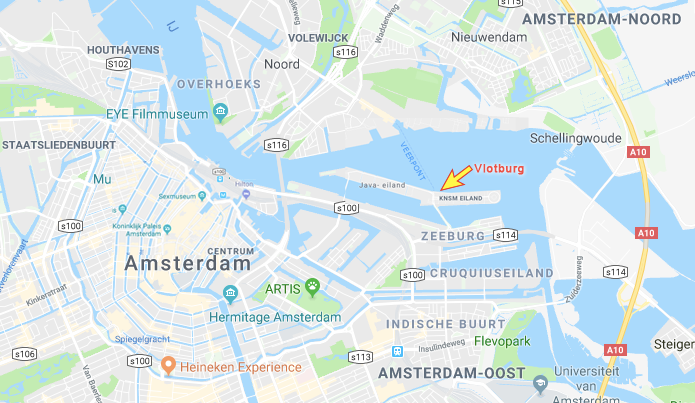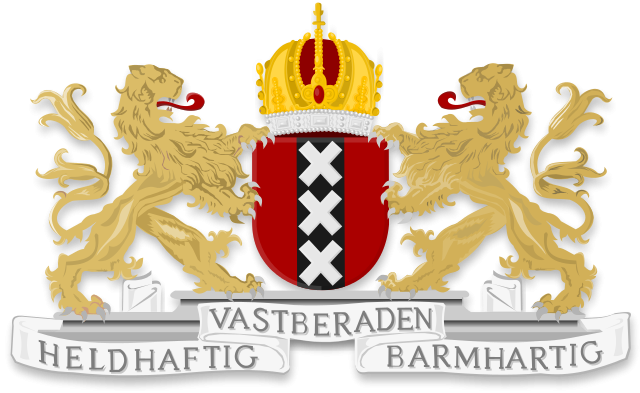| Liegeplätze, Termine und Veranstaltungen |
|
| Museumschip Kasteel Vlotburg in Amsterdam vom 01.01. bis 15.01.2018 |
 |
Discover the middleages on board of Museumship Vlotburg Castle.
We are temporarily in Amsterdam and open for young and old. Or come with your class, we have a special group arrangement.
We are located opposite of:
Surinamekade 6 (near the Azartplein and the ferry)
1019 BV
Amsterdam
+ We are also open during the Christmas holidays
+ Come through Amsterdam Noord (Johan van Hasseltweg), there is a free ferry and free parking

Source: Google Maps
 
History
Main articles: History of Amsterdam and Timeline of Amsterdam Founding and Middle Ages[edit]
The Oude Kerk was consecrated in 1306 Amsterdam is much younger than Dutch cities such as Nijmegen, Rotterdam, and Utrecht. In October 2008, historical geographer Chris de Bont suggested that the land around Amsterdam was being reclaimed as early as the late 10th century. This does not necessarily mean that there was already a settlement then, since reclamation of land may not have been for farming—it may have been for peat, for use as fuel.
Amsterdam was granted city rights in either 1300 or 1306. From the 14th century on, Amsterdam flourished, largely from trade with the Hanseatic League. In 1345, an alleged Eucharistic miracle in the Kalverstraat rendered the city an important place of pilgrimage until the adoption of the Protestant faith. The Miracle devotion went underground but was kept alive. In the 19th century, especially after the jubilee of 1845, the devotion was revitalized and became an important national point of reference for Dutch Catholics. The Stille Omgang—a silent walk or procession in civil attire—is the expression of the pilgrimage within the Protestant Netherlands since the late 19th century.[32] In the heyday of the Silent Walk, up to 90,000 pilgrims came to Amsterdam. In the 21st century this has reduced to about 5000.
Conflict with Spain
A woodcut depicting Amsterdam as of 1544; the famous Grachtengordel had not yet been established
Courtyard of the Amsterdam Stock Exchange by Emanuel de Witte, 1653; the Amsterdam Stock Exchange was the first stock exchange to introduce continuous trade in the early 17th century In the 16th century, the Dutch rebelled against Philip II of Spain and his successors. The main reasons for the uprising were the imposition of new taxes, the tenth penny, and the religious persecution of Protestants by the newly introduced Inquisition. The revolt escalated into the Eighty Years' War, which ultimately led to Dutch independence.[33] Strongly pushed by Dutch Revolt leader William the Silent, the Dutch Republic became known for its relative religious tolerance. Jews from the Iberian Peninsula, Huguenots from France, prosperous merchants and printers from Flanders, and economic and religious refugees from the Spanish-controlled parts of the Low Countries found safety in Amsterdam. The influx of Flemish printers and the city's intellectual tolerance made Amsterdam a centre for the European free press.
Centre of the Dutch Golden Age
The Royal Palace, Nieuwe Kerk, and now demolished weigh house on Dam Square in 1814 The 17th century is considered Amsterdam's Golden Age, during which it became the wealthiest city in the western world.[35] Ships sailed from Amsterdam to the Baltic Sea, North America, and Africa, as well as present-day Indonesia, India, Sri Lanka, and Brazil, forming the basis of a worldwide trading network. Amsterdam's merchants had the largest share in both the Dutch East India Company and the Dutch West India Company. These companies acquired overseas possessions that later became Dutch colonies. Amsterdam was Europe's most important point for the shipment of goods and was the leading Financial centre of the western world.[36] In 1602, the Amsterdam office of the international trading Dutch East India Company became the world's first stock exchange by trading in its own shares.[37] The Bank of Amsterdam started operations in 1609, acting as a full service bank for Dutch merchant bankers and as a reserve bank.
Decline and modernisation
Amsterdam's prosperity declined during the 18th and early 19th centuries. The wars of the Dutch Republic with England and France took their toll on Amsterdam. During the Napoleonic Wars, Amsterdam's significance reached its lowest point, with Holland being absorbed into the French Empire. However, the later establishment of the United Kingdom of the Netherlands in 1815 marked a turning point.
Vijzelstraat looking towards Muntplein in 1891 The end of the 19th century is sometimes called Amsterdam's second Golden Age.[38] New museums, a railway station, and the Concertgebouw were built; in this same time, the Industrial Revolution reached the city. The Amsterdam–Rhine Canal was dug to give Amsterdam a direct connection to the Rhine, and the North Sea Canal was dug to give the port a shorter connection to the North Sea. Both projects dramatically improved commerce with the rest of Europe and the world. In 1906, Joseph Conrad gave a brief description of Amsterdam as seen from the seaside, in The Mirror of the Sea.
Want to read more?https://nl.wikipedia.org/wiki/Amsterdam
Source: Wikipedia |
|
 |
|
| |
|
|
|

